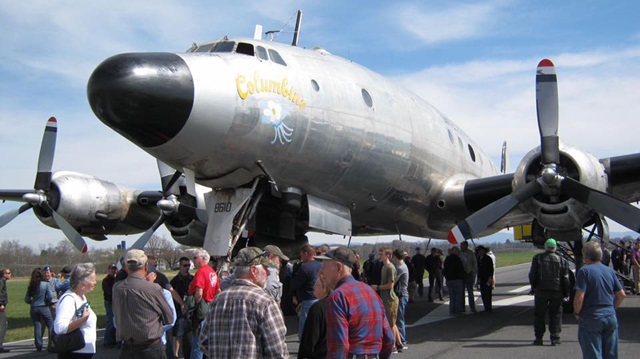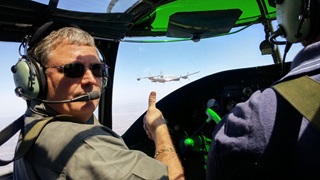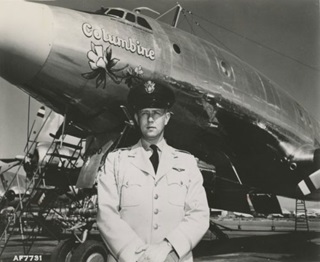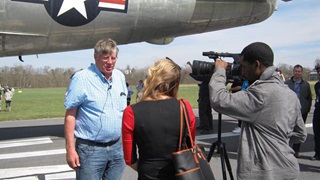
Her bones creaked and the fuel system had sprung a few leaks, but the Connie called Columbine II, with a unique history including service as the first aircraft to fly as "Air Force One" in the 1950s, arrived in Virginia on March 23, welcomed by an admiring crowd.
The Lockheed Constellation bearing U.S. Air Force markings had completed a journey from Arizona, where the dry desert air had helped preserve it for decades, the number on its tail—8610—proving a key to its eventual recognition and salvation. It was also the key to creating the most famous call sign in the world, an idea that came from its U.S. Air Force pilot, Col. William G. Draper, who was requested by name to serve President Dwight D. Eisenhower, a pilot himself who may well have taken the controls from time to time.
Columbine II has a long life ahead of it, thanks to a combination of fortune and the dedication of experts and enthusiasts who are determined to restore the Constellation to its former glory, and fly it on the airshow circuit to tell a unique story about American aviation with four roaring radials and a cabin fit for a president.
First, there was the matter of making it airworthy, a time- and labor-intensive process for an aircraft sold as government surplus in 1968, and once deemed useful only for parts.
“They’ve got a little fuel leak they have to address,” said Ken Stoltzfus, in a March 22 telephone interview, explaining the one-day delay in Columbine II’s cross-country voyage. His twin brother, Karl, owner of Dynamic Aviation in Bridgewater, Virginia, was otherwise occupied fetching required parts needed to complete the journey from Arizona to Virginia, which had made a planned stop at Mount Pleasant, Texas, to visit the Mid America Flight Museum, which has also played a key role in the restoration (and provided photos for this story).

Mid America Flight Museum Managing Director Scott Glover said in a telephone interview that the pre-buy inspection alone had required about 2,000 man hours of labor. Glover and his mechanics, experts in vintage warbirds, participated in that exercise, along with the ensuing restoration required to make Columbine II airworthy, which required another 7,000 to 9,000 hours of expert labor. Not to mention parts.
“It takes a team of people that know what they’re doing and can handle it to restore that airplane,” said Glover, who had considered purchasing Columbine II himself in recent years, but opted not to, knowing well the magnitude of the job ahead.
Columbine II had arrived in Mount Pleasant with a crowd waiting, having already captured the imagination of many. A YouTube video posted in 2014 tells much of the story in five minutes and has been viewed more than 1.6 million times. Reporters were among those awaiting the Constellation's arrival in Texas.
“When they got to Mount Pleasant yesterday he had to do interviews for an hour and a half. They just wouldn’t quit,” Ken Stoltzfus said of his busy brother.
A gasket was found for the master fuel controller (similar in function to a carburetor), and a leaking fuel tank was drained and left empty for the final leg. Another crowd waited in Virginia March 23 to greet Columbine II, whose former pilot created the most famous call sign in the world.

That part of the story was confirmed in part by researchers and staff at the Smithsonian National Air & Space Museum, which also figures prominently in the airplane's rescue from obscurity, and possibly the scrap yard. It was museum staff who alerted former owner Mel Christler in the 1980s that the Air Force C-121 (the Constellation’s military designation) with tail number 8610, then being mined for spare parts, was, in fact, a presidential airplane.
Eisenhower had personally requested Draper’s services when he was elected in 1952, according to one online account that conforms with various others. Columbine II was used for two years, dispatched for longer presidential trips, and in those days, the presidential aircraft used a call sign based on the tail number. On a 1953 flight over New York, air traffic controllers got Air Force 8610 confused with Eastern Airlines 8610, and put both aircraft in somewhat close proximity. It wasn’t a near miss, per se, but it inspired Draper to suggest that presidential aircraft use a distinctive call sign when the commander in chief was aboard to avoid such confusion.
“The news media quickly adapted the term as an all-purpose name for the president’s plane,” wrote Gene Eisman, who worked with Smithsonian curator and author Von Hardesty on Air Force One, The Aircraft That Shaped the Modern Presidency, in an email.
Ken Stoltzfus noted that Columbine II had not flown in decades until this recent cross-country, and much work remains to be done to restore it to its full glory. His brother closed the deal in 2015 to buy the once-famous Connie (whose pilot, and the author of the call sign Air Force One was featured on magazine covers in the 1950s) that was nearly lost to history.

In another interesting footnote, the flight crew that brought Columbine II to Virginia was commanded by Lockie Christler, son of former Columbine II owner Mel Christler, who had harvested parts until learning the Constellation’s unique place in aviation history. Lockie Christler has been the pilot in command of nearly every flight Columbine II has made since its initial rescue from the desert boneyard decades ago, Glover said, the lone exception being a repositioning flight. The last time Columbine II flew before this week was in 1995. Karl Stoltzfus wanted to be sure he had a flight crew with experience, and asked Christler and his crew of three experienced hands to fly Columbine II to her new home.
“It’s going to be an amazing piece of American aviation history to operate,” Glover said, noting he does not have an ownership interest in the aircraft, but takes pride in having helped get it this far. “This is the iconic airplane.”



